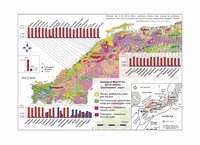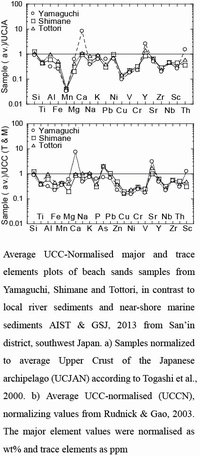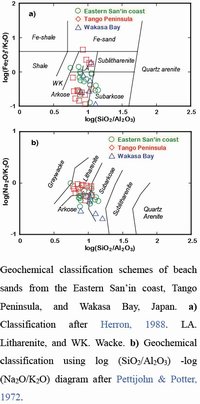Special Program for International Students
GRADUATE COURSE IN EARTH SCIENCE
& GEOENVIRONMENTAL SCIENCE
Current students
Bah Mamadou Lamine Malick (Guinea)
Email: ma.lamine@yahoo.com
Thesis title: Geochemical characterization of sands from pocket beaches in the Japan Sea coast, Inner Zone of Southwest Japan.
Supervisor: Professor Hiroaki Ishiga (2014-2017).
Research outline
My research interest focuses on two broad and distinct areas, Japan and Guinea. The main theme includes the geochemical maturity of pocket beach sands along the coastline of Japan and implication for provenance. An additional focus of my work includes the geochemical and mineralogical characterization of beach sands along Guinea’s Atlantic coasts.
Geochemical maturity of pocket beach sands from the San’in region of southwest Japan
The objective of this study is to conduct a systematic evaluation of geochemical composition of sands sediments collected from the San’in coasts and outline some of the relationships between abundances of elements in sands samples from the 92 sites investigated. The results are used to interpret the maturity of beach sands from the region in terms of geochemistry compared with geochemical composition of 15 local river sediments from AIST & GSJ, 2013a, 15 near-shore marine sediments along the San’in district from AIST & GSJ, 2013b, average upper crust of the Japanese archipelago, according to (Togashi et al., 2000), and average upper Continental Crust (UCC) (Rudnick & Gao, 2003).
Geochemical classification and determination of maturity source weathering in beach bands of eastern San’in Coast, Tango Peninsula, and Wakasa Bay, Japan
This study summarizes the results of an investigation on beach sands samples from Eastern San’in coast (Hyogo and Kyoto Prefecture), Tango Peninsula (Kyoto Prefecture) and Wakasa Bay (Fukui Prefecture), southwest Japan. The main purpose of this study is to determine their classification, maturity, sediment source area, weathering, provenance and tectonic settings to shed light on the source area paleo-weathering conditions at these sites. These factors were evaluated using elemental abundances, weathering indices and elemental ratios in comparison to the average Upper Continental Crust (UCC) and average Japan arc Upper Crust (JUC) as estimated from the representative surface rocks.
Beach sands on the coastline of Conakry, Guinea
The determination of the major and trace element's composition of twenty-nine beach sands samples collected on the coastal zone of Conakry, Guinea has been carried out using X-ray fluorescence (XRF) methods. Textural analysis was conducted on the beach sands samples as well. Factor analysis, cluster analysis and principal component analyses on modal compositions were applied to investigate relations between the quantitative variables. This study focuses on the use of textural and geochemical characteristics (including major and trace elements geochemistry) to determine the maturity, provenance and tectonic setting of the source area of Conakry peninsula, Guinea. Consequently, the objectives of this study are: To present new chemical and textural analytical data of the coastal zone of the Conakry peninsula, Guinea; And to assess the mineralogical maturity of the beach sands. In addition, point out the transport, provenance, weathering history, effect of longshore drift on compositions and mixing processes, and correlate between abundances of major and trace elements. The result of this research will allow me to improve my knowledge of mineralogy, petrology and geochemistry. The use of resources such as the XRF, and some of the advanced application technologies, available at the geoscience department, will enable me to develop an understanding of the subject. Since conducting research and writing manuscripts is a learning process, my intellectual and creative potential will flourish by the time I graduate from Shimane University.
References
The National Institute of Advanced Industrial Science and Technology (AIST) and the Geological Survey of Japan (GSJ).
AIST/GSJ, (2013a) Local River sediment and AIST/GSJ, (2013b) Coastal marine sediment, database accessed on 25/12/2013.
(https://gbank.gsj.jp/geochemmap/shosai_e.htm)
Rudnick, R.L., Gao, S., 2003. Composition of the continental crust. In: Treatise on Geochemistry, vol. 3, pp. 1–64.
(http://dx.doi.org/10.1016/B0-08-043751-6/03016-4)
Togashi, S., Imai, N., Okuyama-Kusunose, Y., Tanaka,T.,Okai,T., Koma,T. and Murata, Y.(2000):
Young upper crustal chemical composition of the orogenic Japan Arc. Geochemistry Geophysics Geosystems
(Electronic Journal of the Earth Sciences), Vol.1, November 27, Page number 2000GC000083.
(http://dx.doi.org/10.1029/2000gc000083)




